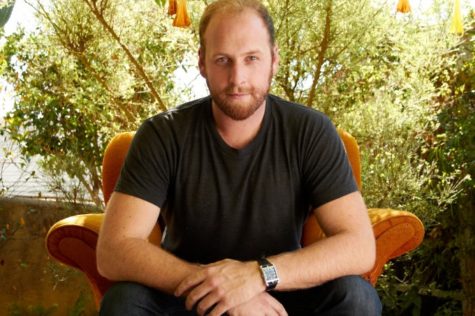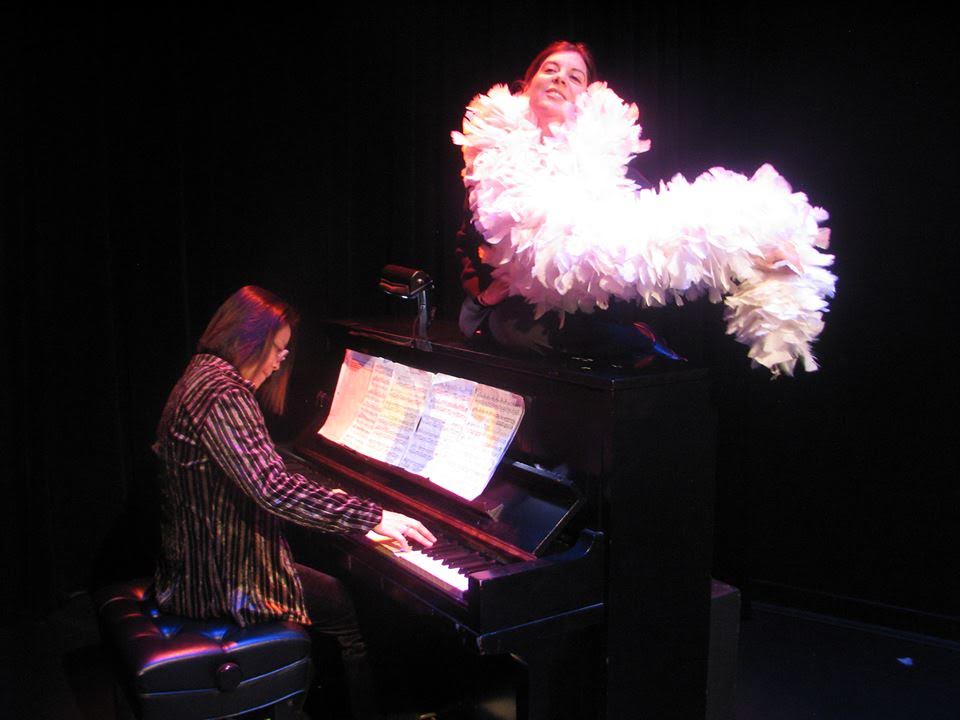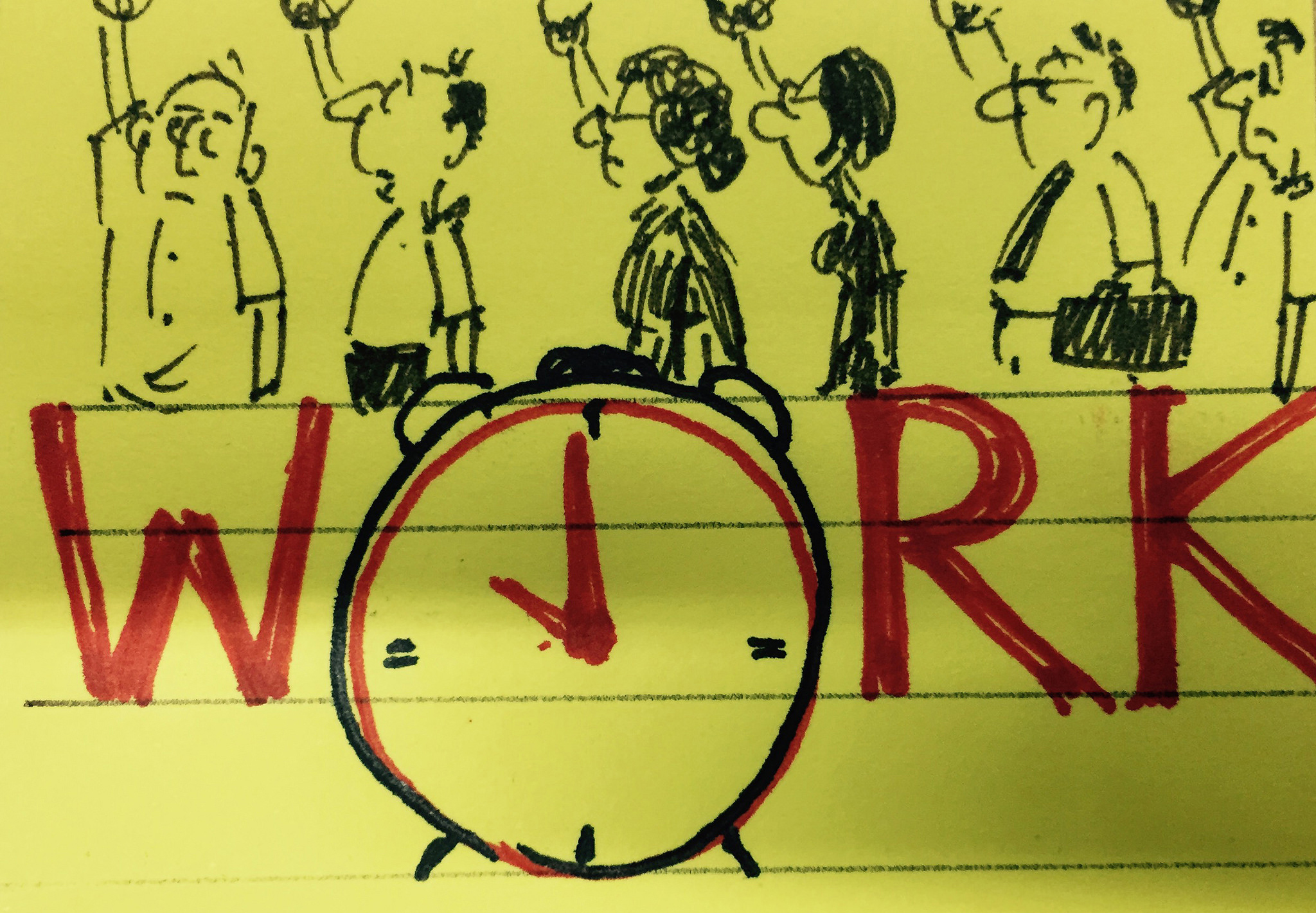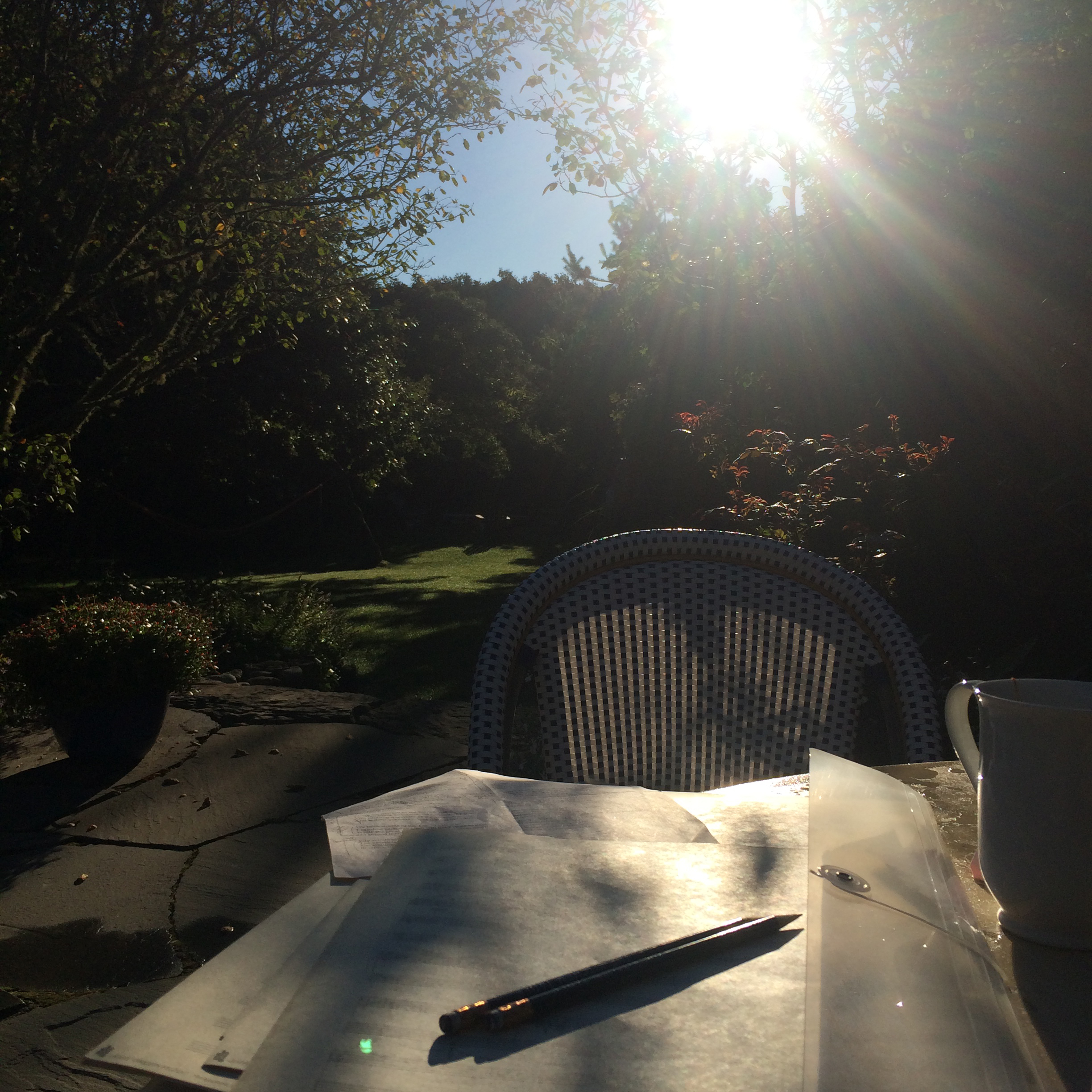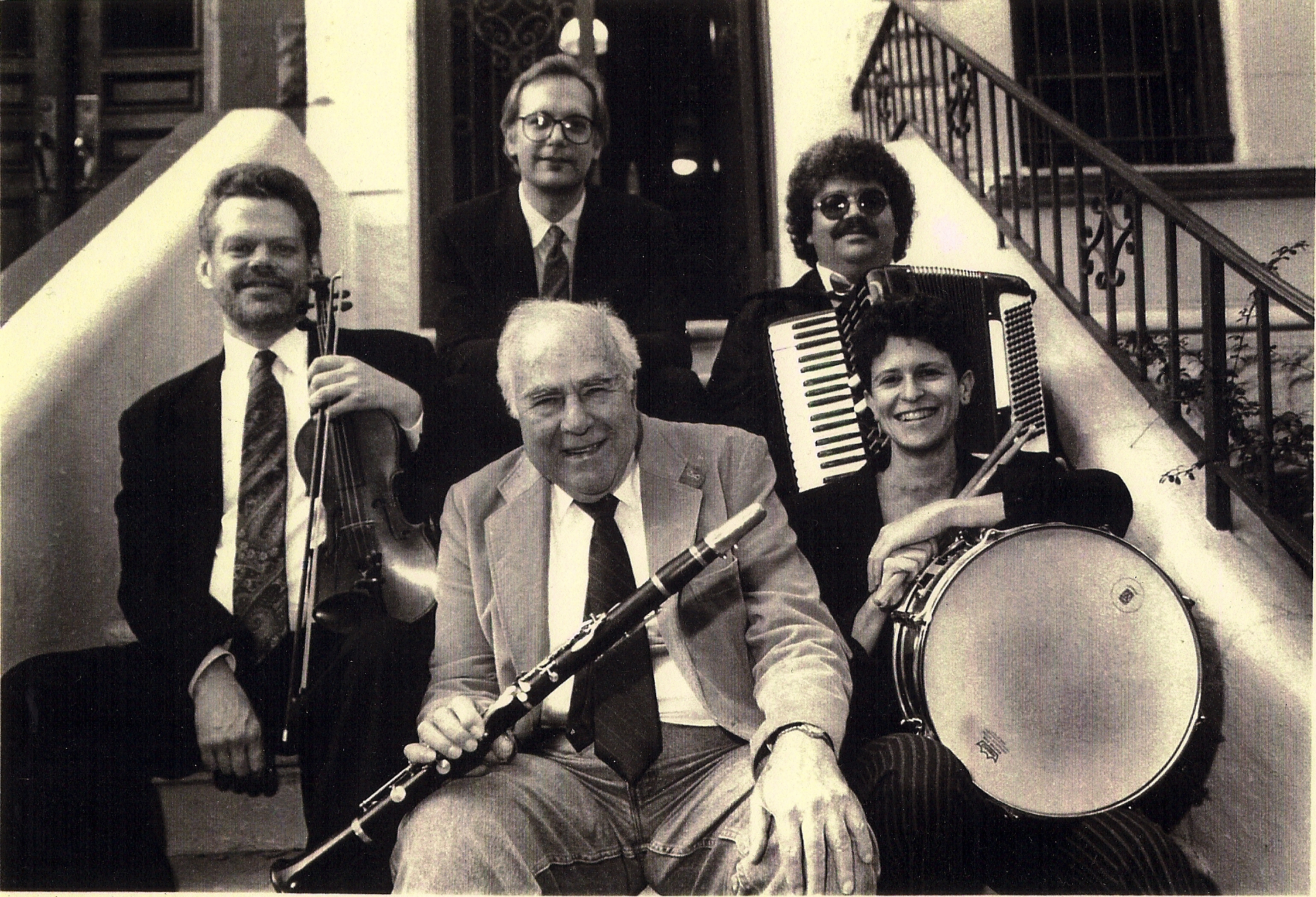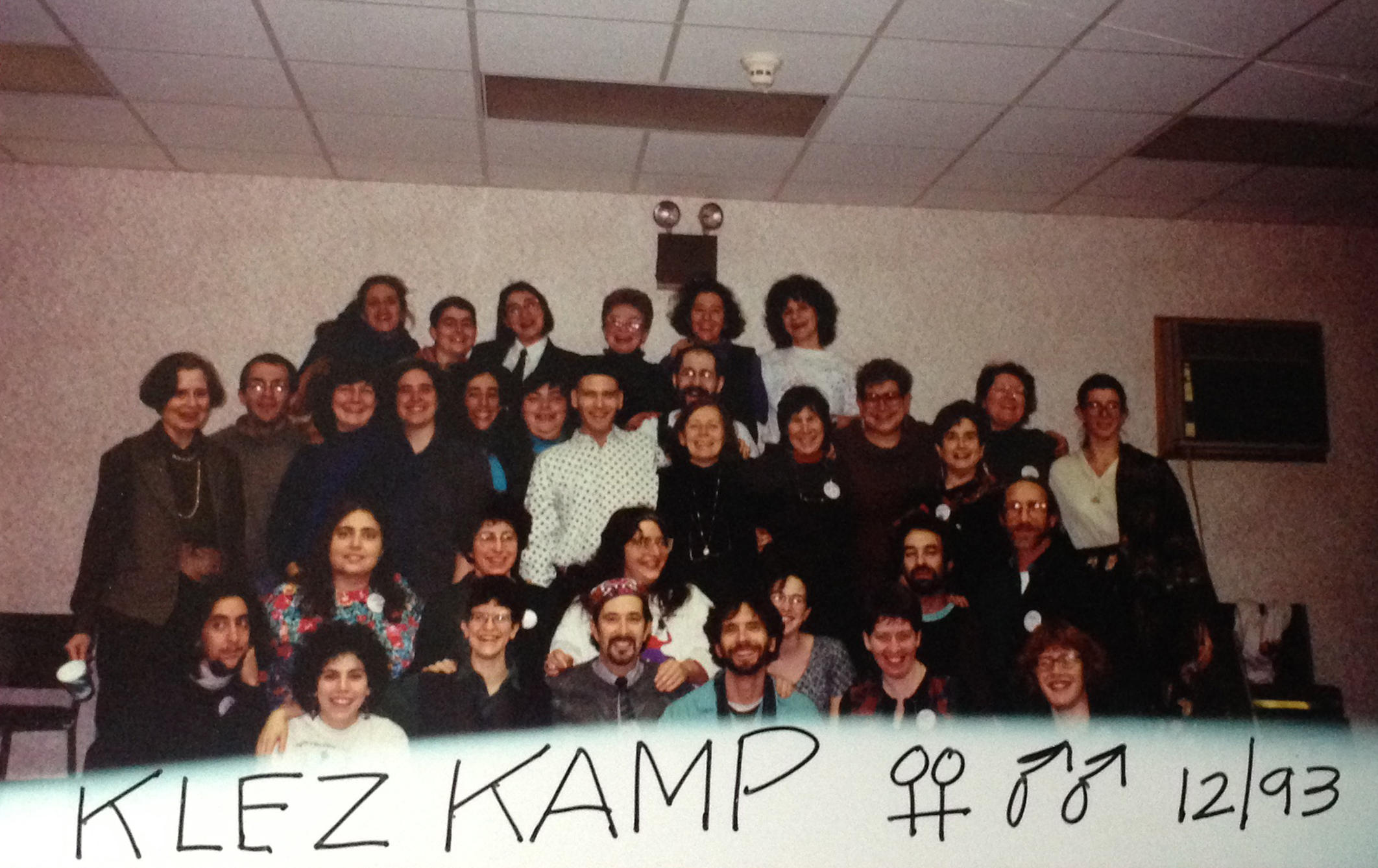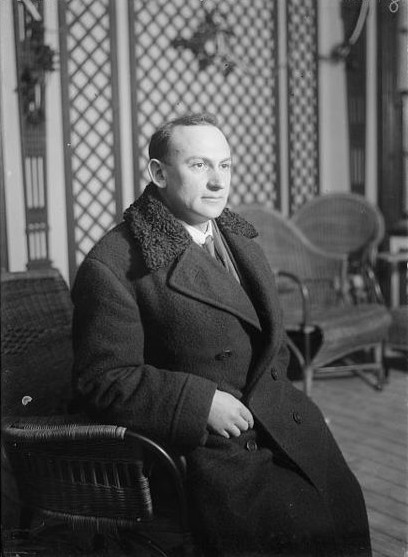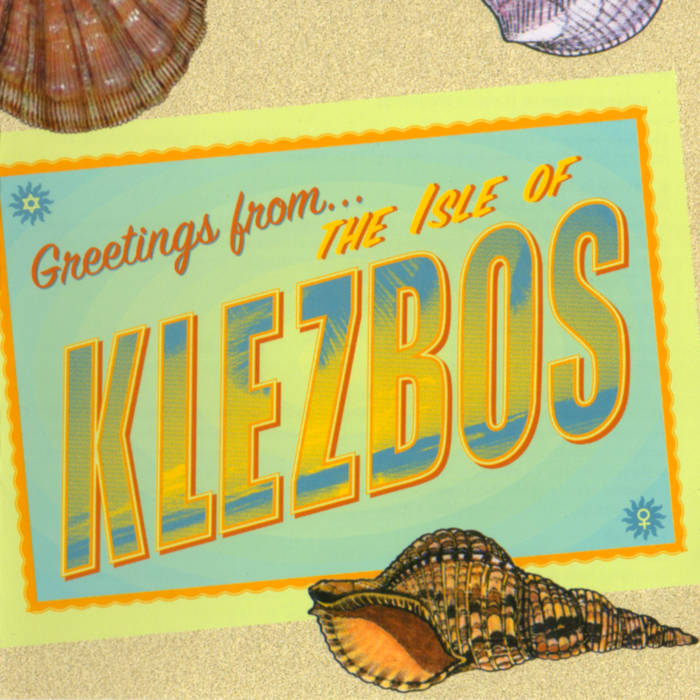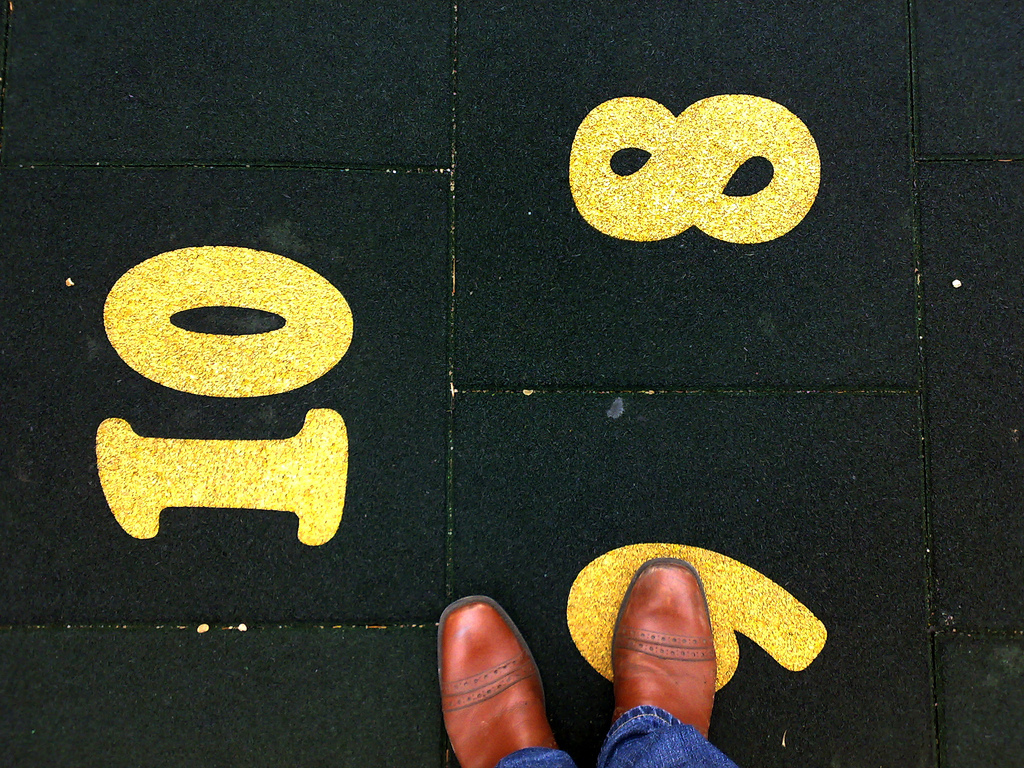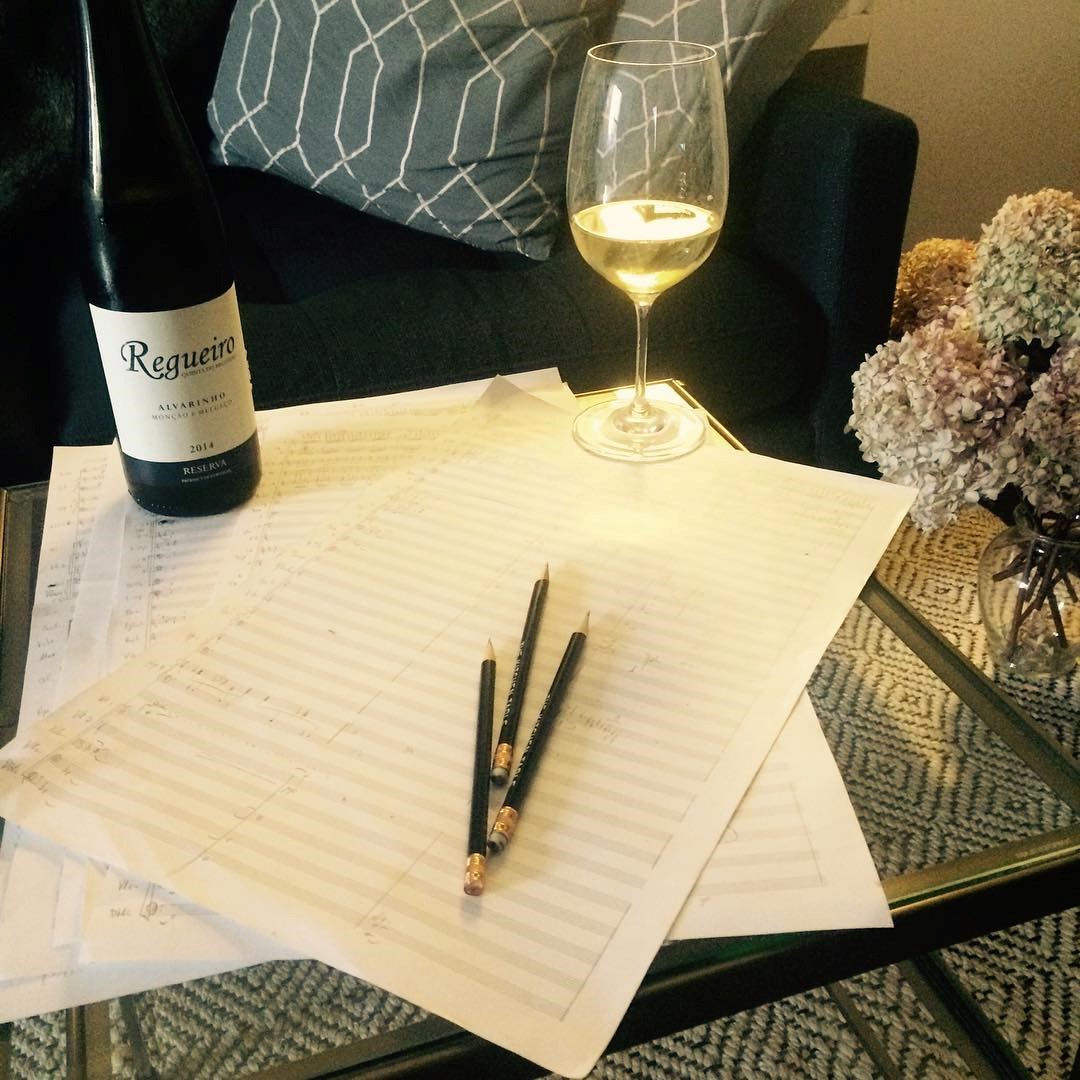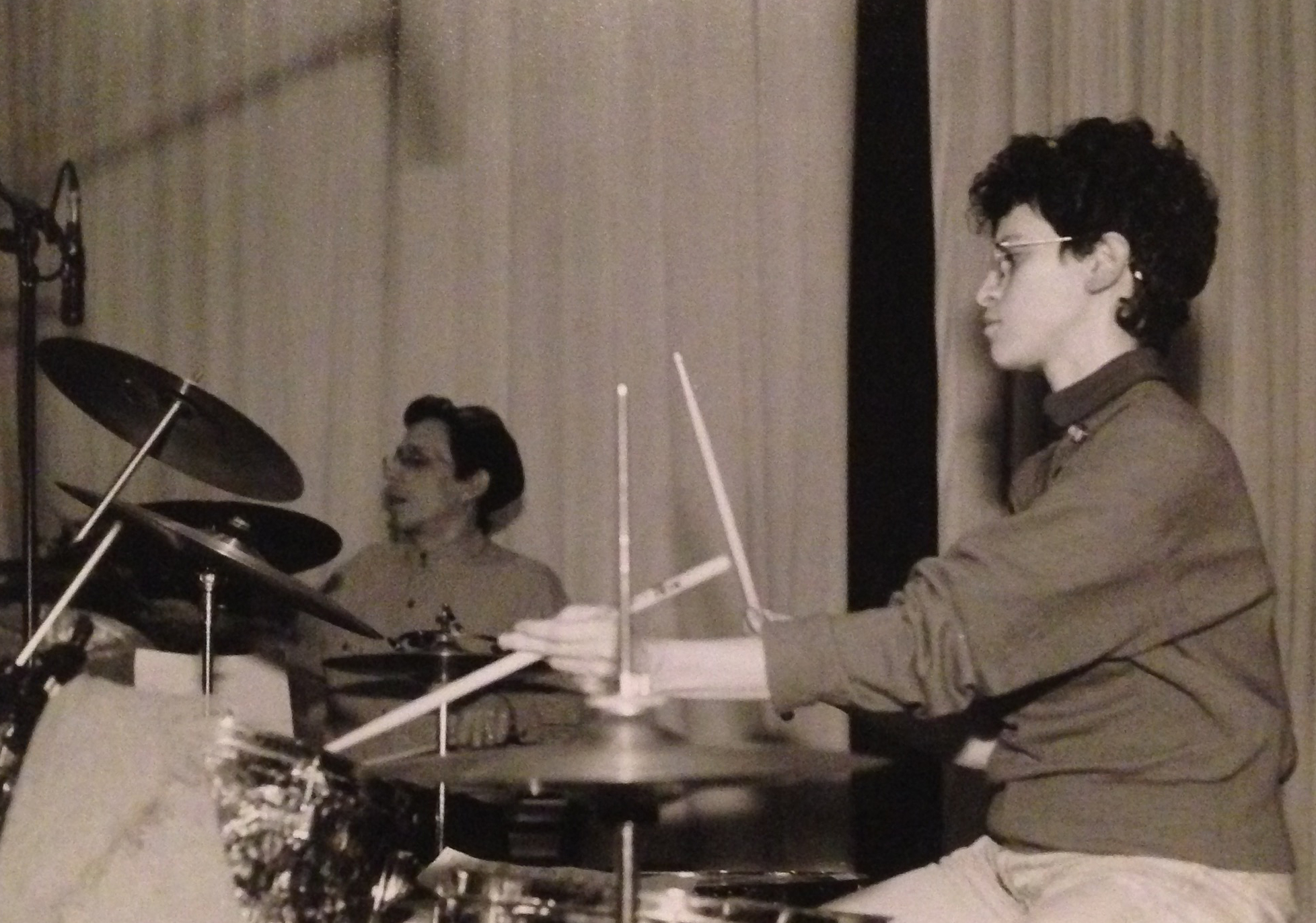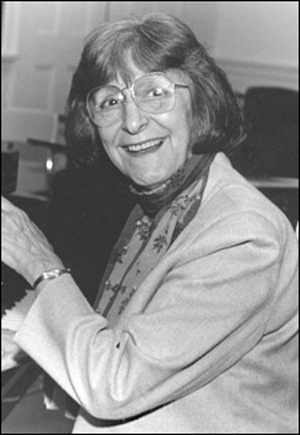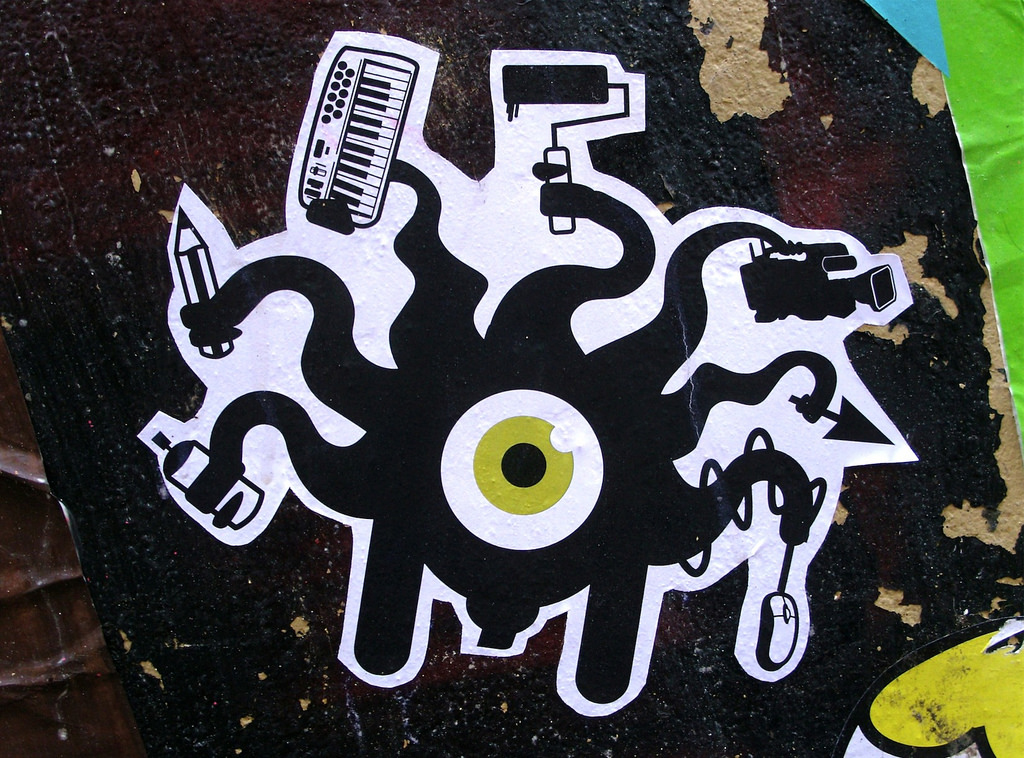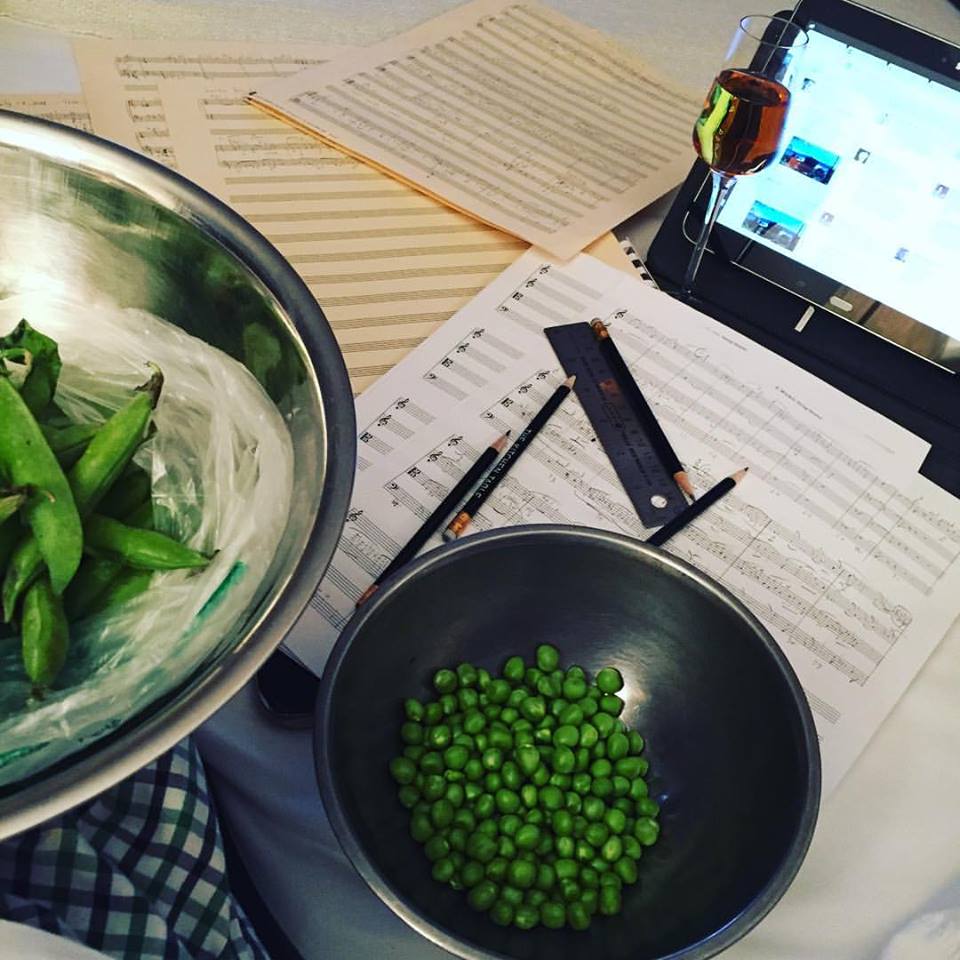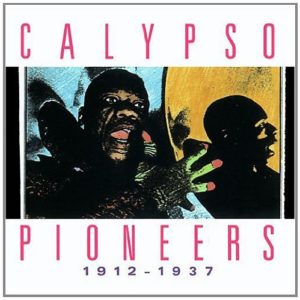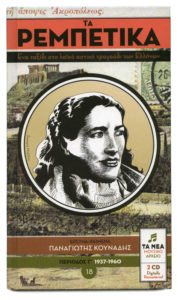
“I hear what you are going for,” Hafez said to me. “You have clearly worked on this music and developed these Indian ornamentations within your improvisation.” It was my first week at the Banff International Workshop for Jazz and Creative Music in 2013, and I was fortunate enough to get a lesson from saxophonist, composer, and conceptualist Hafez Modirzadeh. I had just played a solo saxophone piece that I had developed over the previous couple of years and my adrenaline was pumping a little more than usual. Hafez’s recordings were frequently on my playlist, and I was excited by this opportunity to study with him. After a slight pause to think about my solo, he suggested, “But you know the goal is to move beyond ethnic stylizations towards a concept of universal music.”[1] Universal music? No ethnic stylizations? That blew my mind. “That’s not even my idea,” Hafez continued. “John Coltrane said that.”[2]
I felt the thrill of the unknown. Prior to this lesson, I was fervently driven by a personal mission to express the hybridity of my biology and experience as a half-Indian/half-Euro-American person within my music. The search for stylistic confluence manifested itself in numerous trips to study in India and four recordings of original music that explored Indian concepts, environments, and sounds within my jazz quartet. Despite my commitment to an ethnic-identity-driven music, Hafez’s words resonated deeply within me. On an intuitive level, I knew that this was the next step in my journey. I had a deluge of questions. How is universal music possible? Is not music, like language, born of culture and environment? Is not each musical style a unique expression of place and experience? For years, ethnic stylization had been one of my favorite aspects of music. I treasured the diversity of forms music seemed to take across cultures. Could I really abandon an idea so integral to my identity? In a sense, Hafez’s challenge threw into question everything I believed in artistically. The nature of music itself—what it is, why we make it, and its function in our lives—may not be what I was conditioned to think it is. It was a life-changing moment that sent me down a path of inquiry, exploration, and creative destruction that I am still traversing to this day.
Hafez’s call to action was only the first of many revelatory experiences during that opening week in Banff, Canada. Composer/pianist Vijay Iyer gave me the first building block I would use to develop my ideas surrounding universal music. In a room full of workshop participants, he said something akin to, “Genres don’t exist. They were invented by record companies to sell albums. Genres are an attempt to categorize a community of people who come together and create something.”[3] Once again, I was confronted with a paradigm shift. My musical training, rhetoric, and artistic upbringing had been a world of categories, styles, and genres hinged together. I thought of the countless hours spent trying to play a style correctly and how often I seemed to fail in that goal. At that time, I was already bothered by the mentality that our musical ancestors had somehow received the divine right to invent and that all the rest of us could hope for was to imitate. Yet I was encumbered with the popular notion that I needed to “learn the rules” before I could “break them.” At what point were the rules learned and the breaking could begin? The goal of stylistic execution was perpetually in conflict with my interest as I attempted to occupy both worlds. I embraced Vijay’s comment. He was giving me the words I needed to articulate what I believed and felt all along.
I also tried to untangle myself from some of the ideas about art that hold us back from reaching our imaginative and creative potential.
Over the past three years I have thought long and hard about Hafez and Vijay’s words. It is a topic that I am always eager to discuss with the artistic communities I encounter in my work. Through this series of essays, I am excited to share the recent odyssey that changed the way I conceptualize and create music. Though the story begins in Banff, Canada, it crosses the globe to Kolkata, India, and lands in New York City. Inside these environments, I played music with numerous people and gathered experiences that would contribute towards a concept of universal music. I also tried to untangle myself from some of the ideas about art that hold us back from reaching our imaginative and creative potential. However, before I could start building a model of universal music, I had to remove a large obstacle that was in my way: the genre.
Genres Don’t Exist
As I ruminated on my Banff experience, I began to understand that the idea of musical genre is an illusion that ignores the plurality of ideas, experiences, and sounds that exist within a community. When a sonic experience is reduced to a category, we establish boundaries that inhibit creativity with notions of stylistic correctness. This approach creates myriad problems that throw into question the objectivity that is inherently placed on genre. Among these problems are two issues that I feel are of particular importance.
The concept of genre divorces music from the people who create it.
First, the concept of genre divorces music from the people who create it. In order to define a style, we homogenize seemingly congruent elements across people and time to assemble a grocery list of digestible characteristics. Jazz is reduced to a collection of ride cymbal patterns, walking bass lines, seventh chord voicings, and improvised chromaticism. Hindustani music becomes a modal jam within odd time signatures peppered with exotic ornamentations. Music that was once riding the crest of mutative feedback loops becomes frozen in time. What is left is a shell of compiled theories, historical patterns, and reductive features often devoid of the processes and unquantifiable elements of creativity. The genre now exists abstractly. It looms over us large and menacing as we struggle to determine if this composition is ambient or minimalist and if that improviser is playing hard-bop or post-bop. In our desire to identify the sound, we lose the nuance of each performance that made the music so powerful in the first place.
In his paper “On the Convergence Liberation of Maqam X,” Hafez Modirzadeh addresses the problem of defining and abstracting music:
Essentially, musical systems are neither bound to nor described completely by fixed, geometric abstractions (including scales or tunings), for they are developed qualitatively, through a personal relating to acoustical properties and organizing principles of sound not fully understood through a quantifiable lens.[4]
In this statement, Hafez touches on several critical points. To truly understand the art experience, we need to embrace the unknown. Much in the same way the ancient Greeks resisted the mathematical concept of zero in order to protect their certainty in a static universe, we depend on genre to bolster fixed artistic beliefs.[5] Modirzadeh acknowledges the existence of musical systems while simultaneously liberating them from the world of “fixed, geometric abstractions.” This embrace of the infinite offers an alternative viewpoint to the one fixed by idiom. The unknown allows us to focus on the infinite processes of creativity.
When examining art through the lens of style, we are immediately bombarded by another problem: what person or which group of people has the privilege of defining a genre and its characteristics? In the history of music, the role of the definer becomes a political conflict. Within North Indian communities, the term classical was often attached to raga music as a way to equalize their own complex and highly structured sounds in the context of colonial rule.[6] Definitions of jazz often illuminate racial polarity and social movements in the United States, while European classical forms often frame class and patronage systems. Who has the power to define music? The critic? The academic? The audience? The artist? In the book Forces in Motion, Graham Lock shares Anthony Braxton’s view on definitions of jazz:
The problem with jazz, and this is a point I’d like to stress, is that they’re defining the music in such a way that you cannot do your best. So there’s something inherently wrong with how jazz has been defined. They have it defined now where, if you think of writing a piece for 500 saxophones, you’re looked at as having nothing to do with jazz. Or if you practice your instruments to where you really gain the kind of facility you need, and create the kind of language that expresses that, they say it’s not jazz. Take rhythm. How many articles have I read about the fact that my music doesn’t “swing”? Yet all of the masters have developed their own relationship to forming, to rhythmic contours, etc. The situation now is designed so that jazz is framed in a little box and if you don’t follow in someone else’s footsteps, someone who is so-called jazz, then you’re automatically excommunicated. But all the masters followed their own steps, so it’s a contradiction in terms.[7]
Anthony Braxton immediately challenges the act of defining jazz and the limits these definitions put on creative work. As soon as a category gains specific criteria, such as the common phrase “jazz must swing,” the problem of definitions continues. What is “swing” and who gets to define it? Braxton aligns himself with the masters who “followed their own steps” as a reference to his creative process. This emphasis of process over product further contests the role of the definer as one that is actually removed from the history of the music, rather than upholding it. Ultimately, the act of establishing a genre risks becoming the act of one group of people defining the identities of another group of people.
Our society loves the illusion of a lone genius. When we dig a little further, we uncover the reality that creative work is born of collaboration and community.
Once genre was out of the way, it became easier for me to understand that music is about communities of people. People making sound, people listening to sound, people moving to sound, people navigating sound, and even people trying to ignore sound. In place of static and definitive categories what we have are people. And people are messy. People have fluid identities, can be unpredictable, and are trying to navigate an existence they do not fully understand.
When I started looking at music through the lens of human interaction, what emerged was a world of collaborations. I realized that my favorite works of art were born of very specific relationships that existed within a flowing spectrum of social dynamics. One of my favorite polymaths is J.R.R. Tolkien, whose friendship with C.S. Lewis was pivotal in his work. Tolkien once said of Lewis, “The unpayable debt that I owe to [Lewis] was not ‘influence,’ as it is ordinarily understood, but sheer encouragement. He was for long my only audience. Only from him did I ever get the idea that my ‘stuff’ could be more than a private hobby.”[8] Similarly, Vincent Van Gogh’s brother Theo acted as patron and critic to the artist in addition to his familial role.[9] We could list creative dyads for the rest of this essay: Duke Ellington and Billy Strayhorn, Gertrude Stein and Ernest Hemingway, Pandit Ravi Shankar and Ustad Alla Rakha. Individually these people are certainly hard workers and creative thinkers, but what struck me was the realization that their work was always collaborative. Our society loves the illusion of a lone genius re-inventing genres within a vacuum. When we dig a little further, we uncover the reality that creative work is born of collaboration and community.

Hafez Modirzadeh student ensemble at Banff International workshop, August 2013.
This emphasis on human relationships brings into question the idea of artistic tradition. Tradition implies groups of people sharing behaviors over a course of history, so wouldn’t it be simple enough to replace the word “genre” with the word “tradition”? Yet this also falls into the same trap of categorization. While traditions encompass human activities, it is still too easy to define them as collections of static practices and performances devoid of the immeasurable nuance of artistic process. Traditions fall prey to the same questions that confront styles. They often take on a life of their own and are subject to the politics of definition. Every tradition was at one time a new idea, previously untried and wholly experimental. The process of someone teaching another person how to create a sound will always mutate the practice and performance of that sound.
What is left now that we have crossed out the words genre and tradition? Rather than upholding a tradition, I argue that we are really contributing to a continuum.[10] The continuum implies a process that includes the past, present, and an undetermined future. Instead of working towards a fixed arrival, it allows us to be the next segment of an indefinable shape. The continuum acknowledges that we wouldn’t be in our present state without what has come before, establishes the importance of the present moment as the only one that exists, and allows for a future of unlimited possibility.[11]
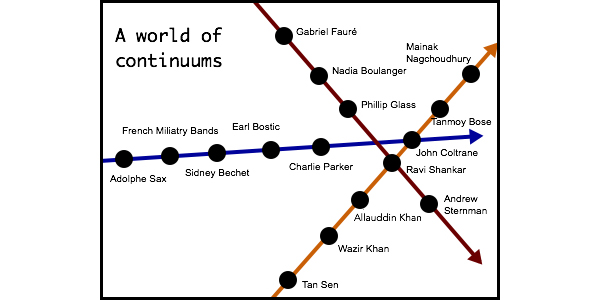
In this argument against genre, I am not suggesting that we eliminate the words bebop, minimalism, or dhrupad from our vocabulary; rather, I am advocating that we change the way we think about and use these words. These words represent people who lived in a very real place and time. They navigated the struggles of life while creating, discussing, disagreeing, and influencing each other. Yes, past communities of people shared musical vocabulary, but each person’s use of that vocabulary was ultimately unique. This recognition that traditions and genres are simply people engaging in the exact same creative processes we have today is liberating. We are no longer obliged to contain our creativity within someone else’s box, and we can take the “greats” off of their pedestals and bring them back down to earth.
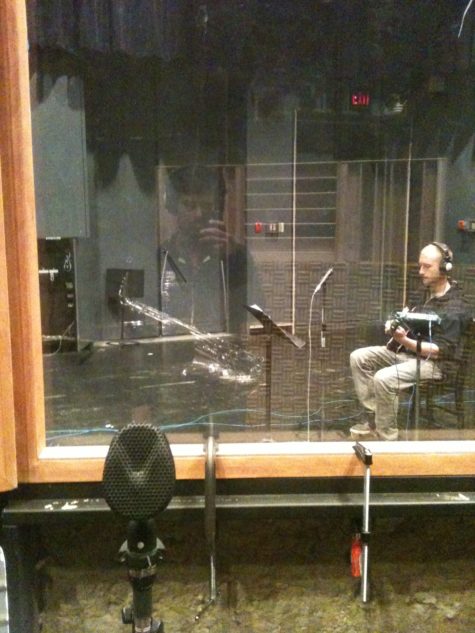
Aakash Mittal and Julius Schwing in the Banff Center recording studio. August 2013.
What Music Can Be
What is left when we have eliminated the terms, groupings, and rules of style? Sound.
This break from categorization and genre towards communities and relationships reveals a universal thread that ties musical continuums together. What is left when we have eliminated the terms, groupings, and rules of style? Sound. It is so simple and yet is so profound. Hafez and Vijay were not trying to tell me to abandon all concepts of ethnic identity. They were encouraging me to see past the illusion of static categorization towards the reality of our nature, which is that we are making sound as part of a spectrum of human relationships.
This emphasis on sound was further clarified for me in a letter the Pulitzer Prize-winning composer John Luther Adams wrote in response to the chairman of a graduate composition program. “My traditional background is sound—an intense love for sound and very little else. The power of sound will always be more important to me than any techniques, conventions or traditions.”[12] Adams’s prioritization of sound over genre allowed him to create imaginative works such as songbirdsongs and Strange and Sacred Noise that blur the lines between the categories that societies use to define art. His music often explores the liminality between sound and noise. Within his music, I hear rigorously composed designs that could be improvised or aleatoric. The process that Adams uses to reach the sound is secondary to the sound itself.
I was similarly struck when the mythologist Joseph Campbell said that “sound is the transcendent unknown”[13] during his interview for The Power of Myth. In simple terms, Campbell is addressing the importance and weight of the sonic experience without reference to genre, style, or even music. The word transcendent implies a journey “beyond ordinary limits,”[14] which can also be viewed as a “bottom-up” approach, whereas genre purports to fill the void with definitive answers where they don’t exist, which could be conversely thought of as a “top-down” approach.
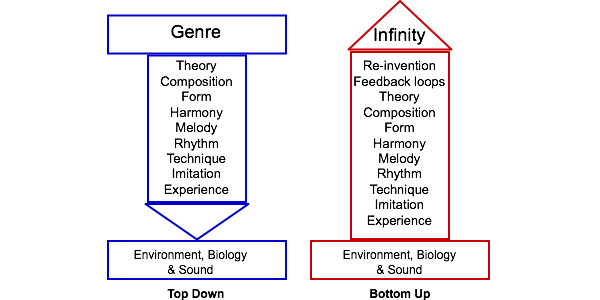
The bottom-up model is a continuum that starts with fundamental elements and experiences that build in complexity and direction over time while moving infinitely towards the unknown. The top-down model starts with a definition or arrival point and works backwards establishing a concrete path towards the destination. The top-down model is useful for many things in life, but all it takes is one hiccup along the way to remember you are actually traversing a continuum.
Without the boundaries of style, we are only limited by our imagination, patience, and stamina.
It is easy to confuse this denunciation of category with the abandonment of rigorous study and hard work. Where would we be without the hours spent practicing etudes, transcriptions, and paltas (north Indian scale patterns) that are so often tied to the concept of genre and tradition within music study? I am not encouraging a rejection of the theory and systematic practice that frequently accompanies the study of a genre. These elements are very important to numerous people’s creative process. Theories often provide tools, logic, and systems for creation. Rather, I am advocating that we prioritize human connections and sound when embarking on a creative endeavor. We can keep theories theoretical and open them up to examination and reinvention. This will allow us to explore the process from which systems emerged and use that process to create our own methods. Let us remember that at the core of our musical traditions are sound and people.
This viewpoint gives us an opportunity to enter a new dimension of creative potential. Without the boundaries of style, we are only limited by our imagination, patience, and stamina. Other people become fellow creators and sound makers rather than members of musical castes. These relationships create landscapes of human activity that generate dynamic and meaningful work. When this work is divorced from top-down constraints, it has the potential to resonate within our primordial being as well as design futures previously unimagined. When we let go of the need for genre and embrace the plurality of sound experiences and human relationships, we become open to “not just what music is but what it can be.”[15] We also take a step toward creating a universal music.
Notes
1. This is how I remember my conversation with Hafez Modirzadeh.
2. Specifically Coltrane said, “If you want to look beyond the differences in style, you will confirm that there is a common base . . . take away their purely ethnic characteristics—that is, their folkloric aspect—and you’ll discover the presence of the same pentatonic sonority, of comparable modal structures. It’s this universal aspect of music that interests me and attracts me; that’s what I’m aiming for.” Quoted in: Porter, Lewis. John Coltrane: His Life and Music. Porter, Lewis. John Coltrane: His Life and Music. Ann Arbor: University of Michigan Press, 1998. pp. 211
3. This is how I remember Vijay’s talk at the Banff workshop.
4. Modirzadeh, Hafez. “On the Convergence Liberation of Makam X.” Critical Studies in Improvisation, Vol. 7, No. 2. 2011, Criticalimprov.com pp. 1
5. Seife, Charles. Zero: The Biography of a Dangerous Idea.. Penguin Putnam Inc. 2000. pp. 46
6. Banerjee, Prattyush. “North Indian Classical Music: Traditional Knowledge and Modern Interpretations.” Lecture presentation at Jadavpur University, Kolkata, India. March 20-22 2014. In south Asian languages it is called Hindustani raga music.
7. Lock, Graham. Forces in Motion: The music and thoughts of Anthony Braxton. Da Capo Press, 1988. pp. 91
8. Carpenter, Humphrey, Tolkein: The Authorized Biography. Ballantine Books, 1978. pp 165
9. Suh, Anna H. Van Gogh’s Letters. Black Dog & Leventhal Publishers, 2006. pp. 9
10. The idea of thinking in terms of continuums was introduced to me by reading Anthony Braxton’s interviews and writings.
11. I chose to represent continuums linearly for the sake of this essay. In reality, I believe they are even more webbed, curved, and more complicated than my simple drawing.
12. Adams, John L. Winter Music: Composing the North. Middletown, CT. Wesleyan University Press. 2004. pp. 31
13. Campbell, Joseph. The Power of Myth, with Bill Moyers. Anchor Books. 1991. pp. 121
14. “transcendent”. Dictionary.com Unabridged. Random House, Inc. 21 Sep. 2016. Dictionary.com
15. This is another Vijay Iyer quote that I remember from Banff.
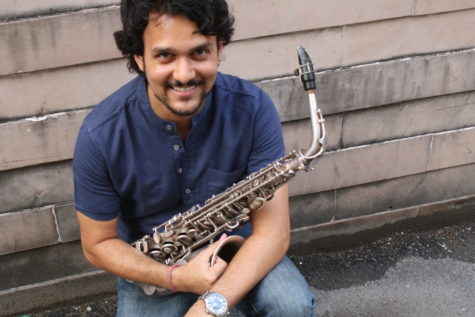
Aakash Mittal
Hailed as “A fiery alto saxophonist and prolific composer” by the Star Tribune (Minneapolis), Aakash Mittal is emerging as an expressive artistic voice. His self-released album, Videsh, has been regarded as, “point[ing] toward new possibilities in improvised music.” (The Denver Post) As a composer and improviser, Mittal employs colorful dissonances, meditative silences, and angular rhythms to express environments and spaces ranging from the American west to the dense streets of Kolkata.
Acknowledgments
Teresa Louis, Matt Moore, Jayanthi Bunyan, and Meera Dugal for reading and reviewing these essays. Molly Sheridan, Frank Oteri, and NewMusicBox for giving me this opportunity and your ongoing support of the new music community. Hafez Modirzadeh and Vijay Iyer for their ongoing support of my artistic growth. New York City Public Libraries for providing a quiet and air conditioned space in which I could work.



